Catalan Modernism in Barcelona
One of the most impressive features of Barcelona is its iconic architecture, characterized by the Modernist style (=Catalan Art Nouveau). The Catalan Modernism movement developed between the late 19th century and early 20th century. This innovative architectural style has shapes and decorations inspired by nature, such as flowers, leaves, and animals. Among the decorative elements used in Modernist architecture are ceramics, mosaics, and wrought iron.
The number of Modernist buildings in Barcelona is large, and among the architects who stand out are Antoni Gaudí (Casa Batlló and Sagrada Familia), Josep Puig I Cadafalch (Casa Amatller and Casa di Les Punxes), and Lluis Domènech I Muntaner (Palau de la Música Catalana and Hospital de Sant Pau).
If you’re planning to visit the Catalan capital, here are the most iconic buildings of Modernism in Barcelona to include in your itinerary.
How to Visit the Best Modernist Architecture in Barcelona
Getting ready to visit Barcelona’s Modernist architecture, you can choose between doing it by yourself or relying on an expert guide.
1. With a Guided Tour
Joining a guided tour with an expert guide is the best way to discover all the secrets and the history behind important landmarks and monuments.
I recommend checking out this guided tour of Gaudí’s works and the Sant Pau Hospital site to discover everything about the rich architectural heritage of Barcelona. Another guided tour you can do is this 3-hour bike tour of Modernist buildings. Fun and informative, you will cycle by Casa Batlló and Palau de la Música, among the others.
2. Save Money with a City Pass (for Individual Visits)
A self-guided tour has the pros of being less expensive and allowing you to stay at your favorite sites as long as you please. If you are taking the time to visit more than two Modernist buildings, save money by purchasing one of the following city passes:
- The Gaudi Bundle (includes the Sagrada Familia, Parc Güell, and Casa Batlló)
- Domènech I Montaner Barcelona’s Pass (skip-the-line access to the Sant Pau Art Nouveau Site and Palau de la Música Catalana)
- Three Houses of Gaudi Pass (includes Casa Batlló, La Pedrera, Casa Vincens)
- The Barcelona Pass (includes the Sagrada Familia and Park Güell, plus a 10% discount to Casa Batlló, Casa Mila, and more).
Best Modernist Buildings in Barcelona
1. Sagrada Familia
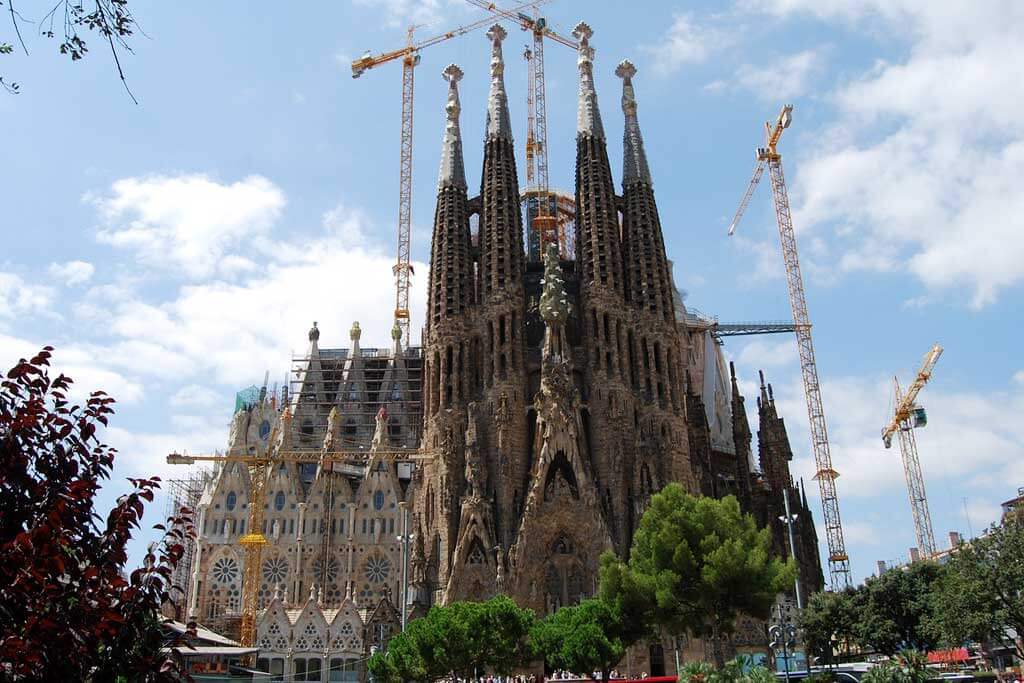
Antoni Gaudí’s last masterpiece, the Sagrada Familia, is an expiatory temple, meaning its construction is funded by voluntary donations to “expire” (forgive) the sins of the donors.
One of the most famous landmarks in Barcelona, the Basilica remained incomplete after the architect’s untimely death and has been a work in progress since 1882. Its architecture mixes the Neo-Gothic style with Modernist elements.
La Sagrada Familia means “the Holy Family” in English. The temple was designed to honor Jesus’s family, with towers representing him, his mother, the four evangelists, and the twelve apostles.
The Sagrada Familia’s interior, which resembles a forest, is particularly unique. The colorful windows and high towers complete the Basilica’s unique architecture.
Check out my quick guide to the Sagrada Familia to plan your visit. When visiting the Sagrada Familia, you can choose from tickets with or without access to the towers. To have the best experience, I recommend this skip-the-line guided tour with access to the towers.
Address: 401 Carrer de Mallorca. Metro Station “Sagrada Familia”, lines 2 and 5. Click here for the opening times.
2. Parc Güell
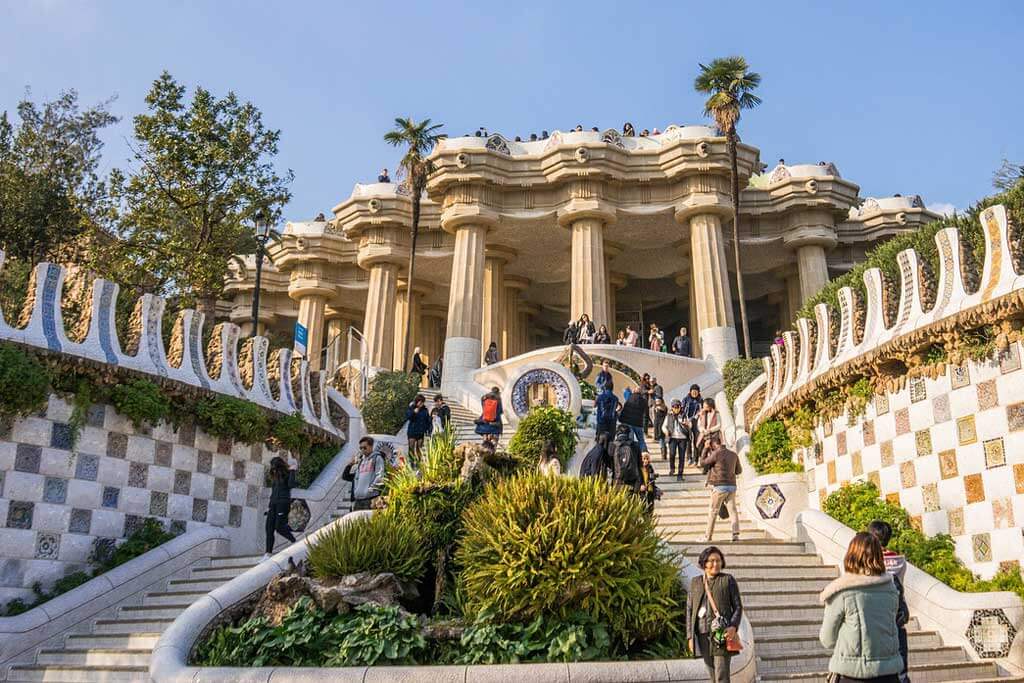
Designed by Gaudí between 1900 and 1914 on behalf of Eusebi Güell, Parc Güell is an architectural wonderland. This urban park features many Modernist elements, first and foremost Gaudí’s trademark technique of the broken tile mosaics, known as “trecandís.”
Strolling around Parc Güell, make sure to stop by the Dragon Stairway, the monumental staircase guarded by the iconic tiles dragon. Other interesting spots in Parc Güell are the Trellis covered walkway, inspired by palm trees twisting their way up towards the sky, and the Hansel and Gretel houses, funnily resembling gingerbread houses.
The Parc Guëll is huge, so I recommend booking this walking tour with an expert guide to be sure you don’t miss the main highlights – Click here to buy your tickets to the Parc Güell
To get to Parc Güell, take bus #116, bus stop “Parc Güell”. There’s a bus stop near the Metro Station “Joanic”, exit “Escorial”, line 4. Alternatively, take this hop-on hop-off bus, which has a stop at Parc Güell.
Address: 11 Carrer d’Olot. Click here for the opening times.
3. Palau de la Música
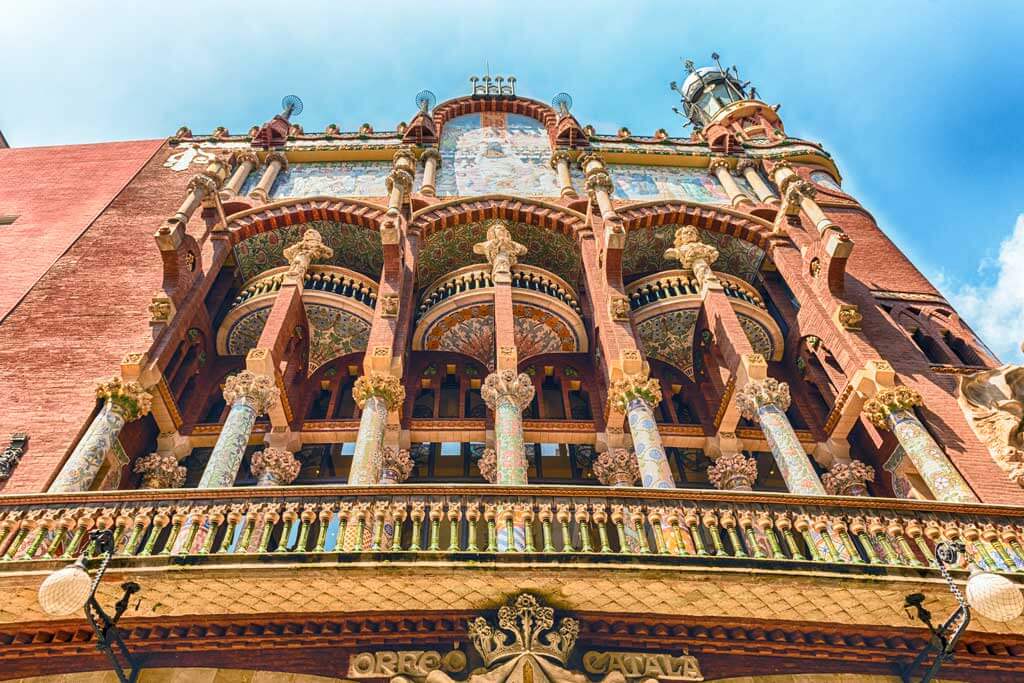
The Palau de la Música Catalana is a phenomenal concert hall designed by Lluís Domènech I Montaner. The Palau de la Música is the only concert hall listed as UNESCO World Heritage.
Built between 1905 and 1908 at the behest of the Orfeó Català Musical Society, it is a building “by the people, for the people”. The funding of the building was by public subscription” for a public who could not afford to go to other more elegant venues like El Liceu Theater. This explains the choice of brick to build the Palau, as it is a popular material.
It’s impossible location, along one narrow street in the El Born neighborhood, makes it difficult to appreciate its beauty, that’s why I recommend visiting the interior with this guided tour or, even better, attending a concert. The building’s most stunning element is the spectacular stained glass skylight. It allows the auditorium to be illuminated by natural lights all day long – Click here to buy your tickets to the Palau de la Música
Address: 4-6 Carrer Palau de la Música. Metro Station “Urquinaona”, line 1 or “Jaume I”, line 4. Click here for the opening times
4. Casa Milà (La Pedrera)
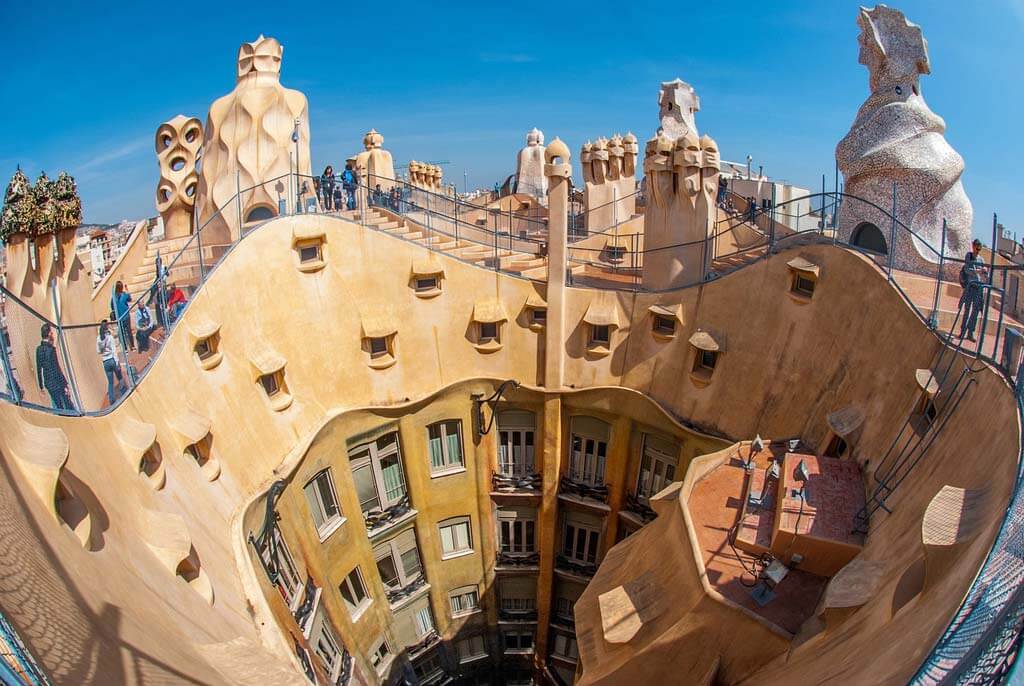
In the Eixample neighborhood, Casa Milà was Gaudí’s last private residential work, commissioned by industrialist Pere Milà i Camps. This iconic building of Modernist architecture in Barcelona was constructed between 1906 and 1910, and it is the perfect expression of Gaudí’s naturalist period.
Initially, Casa Milà was publicly ridiculed because of its design, hence its nickname “La Pedrera” (stone quarry). Today, Casa Milà is considered one of Barcelona’s most important Modernist buildings and is still inhabited.
Visitors can only access selected areas, including an apartment for a Catalan bourgeois family (with original decorations and furniture), the impressive attic that hosts an exhibition dedicated to Gaudi, and the famous rooftop with its iconic chimneys – Click here to buy your tickets to La Pedrera
Address: 92 Passeig de Gràcia. Metro Station “Diagonal”, lines 3 and 5. Click here for the opening times
5. Casa Batlló
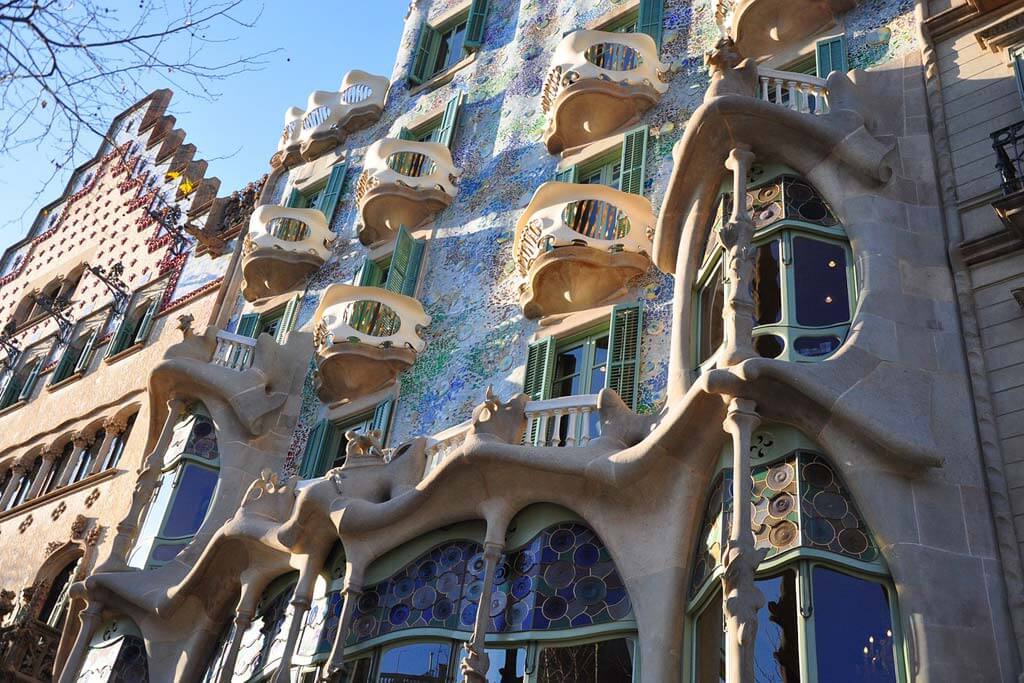
In the Eixample neighborhood, not far from Casa Milà, Casa Batlló is another masterpiece by Gaudí and the flagship building of Catalan Modernism. This building was purchased by textile industrialist Josep Batlló y Casanovas, who asked Gaudí to renovate it completely (facade and interiors).
The renovation works lasted from 1904 to 1907, and they featured elements such as ceramics, stones, and forged iron.
Casa Batlló has an incredible façade with curved lines, decorated windows, and iron balconies. The roof resembles the back of a dragon, while the interior of the house is designed to give the feel of being underwater.
Casa Batlló offers different tickets (blue, silver, gold) with which you can visit more or fewer parts of the building – Click here to buy your tickets to Casa Batlló
Address: 43 Passeig de Gràcia. Metro Station “Passeig de Gràcia”, lines 3 and 5. Click here for the opening times
6. Casa Amatller

Architect Josep Puig i Cadafalch’s most famous work is Casa Amatller. This interesting Modernist – Neo-Gothic building is right next door to Casa Batlló, and it is part of the famous “Illa de la Discòrdia” in the Eixample neighborhood.
Built for chocolate industrialist Antoni Amatller in 1898, this building is full of symbolism and decorative elements. A richly decorated facade with iron balconies and ridged cornic with ceramic tiles and gargoyles beautifully complements the building’s interior. The most striking feature of Casa Amatller is the stained-glass windows of the caretaker’s office.
Today, the building is a museum displaying an impressive collection of furniture, sculptures, ceramics, and paintings by Catalan Modernist artists. Best of all: Casa Amatller sees one third of Casa Batlló’s visitors! – Click here to buy your tickets to Casa Amatller
Address: 41 Passeig de Gràcia. Metro Station “Passeig de Gràcia”, lines 3 and 5. Click here for the opening times
7. Hospital de Sant Pau
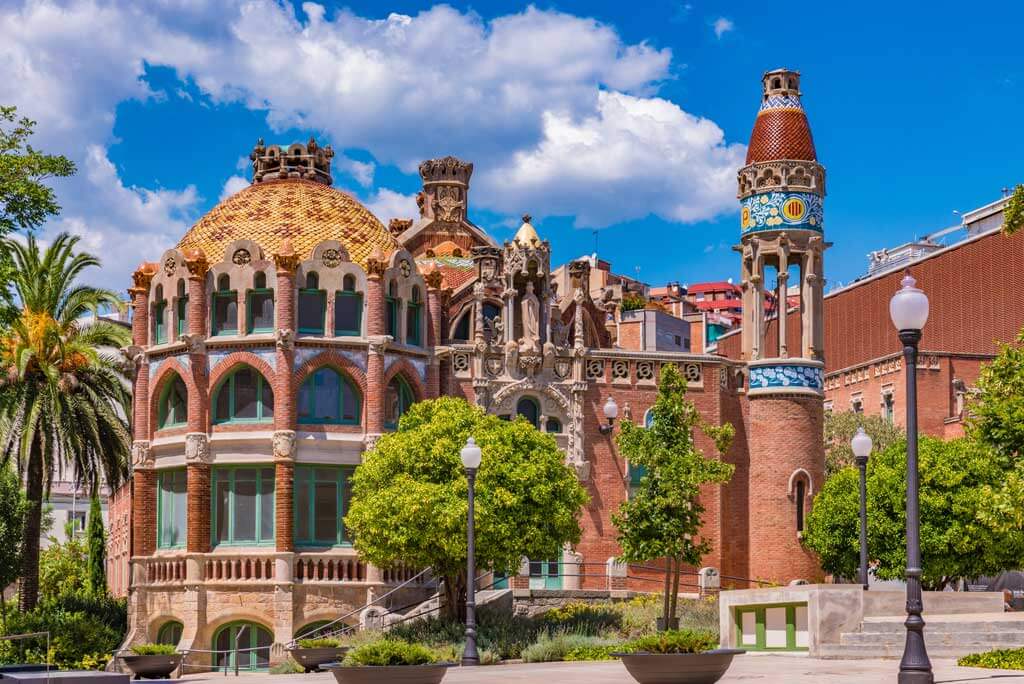
The Hospital de Sant Pau is the largest Modernist complex in the world, and it was designed by Lluís Domènech i Montaner.
A working hospital until 2009, the complex was commissioned to the architect by local benefactor Pau Gil. It took almost 30 years to complete, opening its doors in 1930.
With 12 pavilions connected by underground tunnels and a central palace, the complex is characterized by a design inspired by nature. Because of its size, unique architecture, and endless fascinating details, I recommend visiting this wonderful place on a guided tour.
Address: 167 Carrer de Sant Antoni Maria Claret. Metro Station “Sant Pau | Dos de Maig”, line 5. Click here for the opening times
8. Palau Güell
Located in the El Raval neighborhood, a few steps away from the iconic La Rambla, Palau Güell is another building designed by Gaudí for his friend and industrial tycoon Eusebi Güell. Built between 1886 and 1890, Palau Güell may not look like one of Gaudí’s works from the outside, but you just need to step inside to discover a spectacular interior.
This private residence’s workrooms, library, and bedrooms boast all the typical elements of Gaudí’s design. The roof terrace of Palau Güell is particularly impressive, featuring 20 chimneys decorated with striking mosaics – Click here to buy your tickets to Palau Güell
Address: 3-5 Carrer Nou de la Rambla. Metro Station “Dressanes” or “Liceu”, line 3. Click here for the opening times
9. Casa Vicens
Casa Vicens is Gaudí’s first masterpiece, and it was built in 1883 as the summer residence of stock and currency broker Manuel Vicens.
The construction of this house kicked off the Modernist movement by the use of some of the characteristics of the style.
However, don’t expect to visit a “classic” Modernist building, as Casa Vicens also has plenty of Moorish and Neoclassical elements. But it is super beautiful! – Click here to buy your tickets to Casa Vicens
Address: 20-26 Carrer de les Carolines. Metro Station “Fontana” or “Lesseps”, line 3. Click here for the opening times


